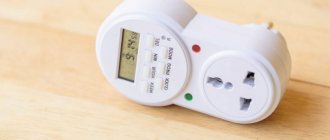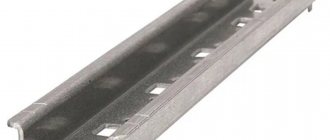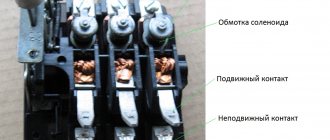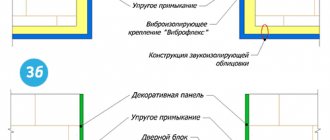Electrician in the house
Encyclopedia about electricity from A to Z
Masters catalog
Find the best master or company in your city
TV socket
TV antenna sockets have recently become increasingly popular. After all, they allow you to hide utility networks and significantly simplify the connection of video equipment to it.
At the same time, such sockets have a fairly attractive appearance, allow you to create your own local network for television, and also reduce the level of interference in such a network.
- Connecting TV sockets Connecting TV sockets using a pass-through design
- Connecting TV sockets according to the star scheme
- Single socket or star socket
Main types
There are three types of devices.
Single TV socket, used independently, suitable for laying one wire and installing one TV. There is one entrance and exit here. Minor signal loss may occur (maximum 1.5 dB).
- A pass-through model is required if you need to install two or more TVs. It has one input and two output terminals. The first pin is intended for connection to the next socket, the second – with the cable from the TV.
- Feature: Stable transmission is ensured, however, the flow on the outgoing wires may decrease.
The terminal device terminates the connection in pass-through circuits. Additionally equipped with a 75 Ohm resistance (anti-interference).
By the way. Terminals in sockets can be in the form of clamps or bolts (a hybrid of both is possible). This design simplifies installation.
Installation features
To connect a TV socket, you need to remove the insulation from the central core of the TV cable at a distance of 20-25 mm from the end of the cable. Make sure that the braided wire and screen foil are not damaged. Then bend the braid and foil over the cable sheath and strip the insulation so as to expose the core of the wire, leaving 1-2 mm of insulation near the screen. After this, the cable is inserted into a special hole, and its central core is fixed in the socket device. The installation method will vary from manufacturer to manufacturer.
It is better to entrust the installation to a specialist, since there are cable laying standards that, if not observed, can result in interference. For example, if you use RG‑6 type wires, you need to maintain a distance between the power and antenna cables. The gap should be 3 cm or more.
Other classifications
Devices vary depending on the signal received:
- TV – terrestrial signal;
- R – reception of radio signals;
- SAT – satellite broadcast.
By the way! Combinations of these options are available for sale (TV+R, TV+SAT, TV+R+SAT). The corresponding designation of TV sockets can be found on their housing.
According to the installation method, sockets are divided:
- Hidden wiring;
- Wall mounting.
Components
Regardless of the type of model, it consists of the following parts:
- Housing (printed circuit board);
- The front part (panel) protects the mechanism from damage (the color can be chosen to match the interior);
- Adder, allows you to connect a satellite and radio transmitter;
- The clamp is used to secure the socket in the mounting box.
How to connect
There are four schemes for connecting TV sockets.
Single option, used for one TV. In this case, the cable is routed to the point where the TV is placed. A socket box is installed at the end of the wiring, and then a socket is mounted on top.
On a note! It is recommended that the supply of wire in the installation box be up to 30 cm, which will simplify the work.
Star (parallel method), most popular when connecting two or more TVs. A splitter (separator) is necessarily used here; it is mounted at the beginning of the wiring. This element may have a different number of inputs and outputs.
REFERENCE. The splitter distributes the signal evenly across all devices. The equipment receives broadcasts of the same power, without distortion.
- Plus: signal continuity is ensured (damage on one line will not affect the operation of other TVs). Disadvantage: increased wire consumption. Serial connection is used with insertion of feed-through sockets. The wire passes sequentially from one module to another, the connection is completed at the terminal model.
- Advantage: material consumption is reduced.
Flaws:
- Damage in one section will affect the functioning of all subsequent devices;
- The signal strength weakens in some cases.
The mixed scheme contains both pass-through and single modules. They are powered by a separator. This method is chosen if a large number of sockets are provided. The method is used infrequently, but it reduces installation costs and complexity.
On a note! In all cases, an amplifier may be required when more than three TV panels are connected, or a large length of wiring is used. It is placed at the cable entrance to the home. This will ensure broadcast stability. This measure is not relevant if TVs with an automatic gain option are installed.
Tips for choosing the right one
The following recommendations will tell you which GSM socket is best to choose for your needs.
To avoid mistakes, pay attention to the following:
Manufacturer. Buy a product from a better known and reputable brand. The most popular are Sapsan, Siberian Arsenal, Tantos, ORCAM and Proline.
Available functionality. There is no point in buying a fancy model to turn off a forgotten iron and boil water to make coffee.
Number of connectors. Be smart about choosing a model with a certain number of outlets. There should be, if possible, exactly as many as required.
Power. This criterion is one of the most important, especially in the case of a power strip where several pieces of electrical equipment are connected. The permissible power reserve must be at least 30% of the maximum load.
Any additional features can significantly increase the cost of the product, so try to accurately determine the need for a particular function.
Laying methods
This nuance is especially important for apartments with design. It is necessary to lay the lines so that they do not stand out against the surrounding background.
When a house is under construction, this point needs to be thought through in advance. The wire is masked using three methods:
- Decorative finishing treatment;
- Behind the ceiling covering;
- Laying in the wall, followed by applying plaster.
By the way. With the hidden method, appropriate sockets are selected.
If the wiring is external, it is hidden in a plastic box or pipe. The corrugation is fixed to the surface with plastic clips.
If desired and possible, you can hide the line behind the baseboards.
Characteristics
- White color
- Collection: Inspiria
- Frame included: no
- Type: Single
The technical characteristics of the product may differ from those indicated on the website; please check the technical characteristics of the product at the time of purchase and payment. All information on the site about products is for reference only and is not a public offer in accordance with paragraph 2 of Article 437 of the Civil Code of the Russian Federation. We kindly ask you to check the availability of the desired functions and characteristics when purchasing.
All products sold by the online store are completely new and have a warranty period at the manufacturer's service centers or at the ONLINE TRADE.RU service center. Buyers who purchase digital photos and videos, peripheral devices, communicators or other equipment in our store, along with the goods, receive a sales receipt and a warranty card stamped by our store. Go to the warranty section
Cable preparation
First of all, determine the type of wire. It should provide minimal signal attenuation. It depends on the installation method:
- Hidden wiring – SAT 703, SAT 50, RG 11, etc., are characterized by good insulation and durability;
- The open method is less demanding; RG 6 or its analogues are suitable.
They start by stripping the cores (with a technical knife or wire cutters). The upper shell is removed to a length of up to 25 mm.
Attention! You need to act carefully so as not to damage the screen.
There are three options for the shielding layer:
- Aluminum layer;
- Copper braid;
- A combination of these materials.
By the way. If the wire diameter is less than 0.7 cm, the screen is turned over the sheath. This measure will ensure tight contact with the device connector.
Why call a professional if you can do it yourself?
If you do not have construction skills and knowledge of electrical network diagrams, then you can, of course, call a specialist so as not to make a mistake that could lead to serious troubles in the form of a short circuit or fire.
But we will still try to explain how to install a junction box with our own efforts. And it must be said that the entire process of such work is not labor-intensive or highly complex. You just need to familiarize yourself with the rules for connecting wires, learn how to use them and have patience. Next, let's look first at the practical implementation of this work:
We choose a place to install the distribution box, taking into account the comfortable access necessary for troubleshooting, since dismantling walls, ceilings or floors does not seem to be a very pleasant undertaking.
If necessary, you can create several distribution boxes in a room, since sometimes in one room there may be several consumers requiring increased voltage. And in order to reduce the load, this option is considered a very profitable way out of the situation. You can use pass-through and end boxes.
Before installing the box on the surface of the wall, ceiling or floor, we ensure optimal access to it to create internal wiring connections. And do not forget about creating a supply of cables for input and output. Due to this, you can easily disconnect the box from its installation location if necessary.
Now you know how to create an indoor distribution box installation. We have talked about this as simply as possible so that anyone can get basic information about the process of installing a junction box. For everything to work correctly, it is necessary to connect the boxes from the input point to the rest of the wiring points for consumers.
It’s very important to do everything efficiently right away and not leave it for later - I’ll finish it later, because now it’s working well. This may lead to an unexpected ending in the near future, and believe me, you won’t like it
Height
The socket is mounted on the same level as the TV panel. If a wall-mounted TV is installed, the module is placed behind it. This solves two issues at once: aesthetics and safety (inaccessibility for children or pets).
Spectacular performances
The show is hosted by two Timurs - Rodriguez and Batrutdinov. The latter, by the way, was a participant in the second season of “The Mask”.
But the host of the show “Mask” became a contestant in the new program. Vyacheslav Makarov presented the folk song “I’ll go out into the street.” Mark Tishman chose Muslim Magomaev's hit "Nocturne". Yulia Parshuta surprised everyone when she performed the Queen song “Bohemian Rhapsody”. Alisa Mon presented a cover of Kylie Minogue's hit Can't Get You Out Of My Head.
Kirill Turichenko sang Diana Arbenina’s composition “A Second Ago.”
Guest Yusif Eyvazov, invited to the show, recalled how he discovered Turichenko in the “Mask” show. Eyvazov acquired in Kirill not only a good friend, but also a business partner. In March next year, the artists will give a joint concert in Moscow.
Connecting the wire to the socket
In conventional models, you need to remove the cover of the device to expose the connectors. If the contacts are located on the reverse side, dismantling is not required.
The cable core is fixed in the socket. For optimal connection and protection against breakage, part of the braid is fixed with an additional screw.
Connecting TV outlets is a simple task.
- However, you should take into account the amount of equipment used, ensure sufficient signal power and take care of aesthetics.
- By following the recommendations of this article, the homeowner will be able to create a reliable TV connection scheme with reliable reception and will not encounter technical problems in the future.
Content
In ancient times [edit | edit code ]
The hexagram is an international symbol of very ancient origin. It is known in India as Anahata or Anahata-chakra, also as Sudarshana or Sudarshana-chakra [ source not specified 63 days
] . Apparently, he appeared in India earlier than in the Middle East (where he figured in the cult of Astarte) and in Europe. Initially, the hexagram was not a specifically Jewish symbol and had no relation to Judaism [1].
Starting from the Bronze Age (late fourth - early first millennium BC), the hexagram, like the pentagram, was quite widely used for decorative and magical purposes among many peoples so distant from each other geographically, such as the Semites of Mesopotamia and Celts of Britain. On the Iberian Peninsula, images of hexagrams dating back to the Iron Age before the arrival of the Romans were found [2]. The pentagram was used as a magical symbol much more often than the hexagram. However, both geometric figures are found in illustrations of medieval books dedicated to alchemy, magic and witchcraft [1].
The earliest undisputed depiction of a hexagram in the Middle East was discovered on a Jewish seal of the 7th century BC. BC, which belonged to a certain Yehoshua ben Asaiah and was found in Sidon (although there is evidence of an image of a six-pointed star discovered during excavations on the wall of a building from the era of King Ahab, who ruled in the 9th century BC [3], this image is too erased and ambiguous and the very fact that it represents a six-pointed star is disputed [4] ). Later, similar stars were used to decorate both household utensils (including seals and lamps) and many ancient synagogues, starting from the Second Temple period. For example, the frieze of the synagogue in Kfar Nahum (Capernaum) (II-III centuries AD) is decorated with an ornament in which six-pointed stars and swastikas alternate. Hexagrams decorate the floor of a Roman villa excavated at Ein Eyal near Jerusalem. Thus, apparently, during this period in the Middle East, the six-pointed star was not yet given any significance other than decorative [5]. In addition, it is known that during the Hellenistic period this symbol was not associated with Jews. Theories declaring the hexagram an astrological symbol of Saturn or linking it with the sacred stone of the Jerusalem temple of the period preceding the reign of David have not received confirmation [2].
Long before the hexagram acquired the status of a Jewish symbol, this role was played by the menorah - the temple lamp. The menorah, as opposed to the cross, has been used since the 2nd century AD. e. Jewish burials are celebrated in the Diaspora and in Palestine, and from that time on it became an attribute of the design of synagogues [6]. At the same time, there are modern theories that link the six-pointed star as a symbol specifically with the shape of the menorah candlesticks (see Versions about the origins of the Star of David as a Jewish symbol)
.
Middle Ages[edit | edit code ]
In the Middle Ages, the six-pointed star was widely used as a symbol in the Old World. The kings of Navarre in the 10th and 11th centuries placed it on their seals. French, Spanish, Danish and German scribes - both Christian and Jewish - also used the hexagram and pentagram as an element of seals. In Christian churches, the hexagram, sometimes with slightly curved lines, was a common fragment of ornament. It can be seen on a stone from the early Christian church in Tiberias, at the entrance to the Burgos, Lleida and Valencia cathedrals, on the marble episcopal throne of the Cathedral of Anagni [2]. It was found on early Christian amulets and in Muslim ornaments under the general name “seal of Solomon” [5].
The earliest mention of the name "Magen David" ("shield of David") probably dates back to the early Middle Ages - the era of the Babylonian geons (it first appears in Talmudic literature as one of the names of God [3]). King David's magical shield is mentioned in a text interpreting the magical "alphabet of the angel Metatron." This shield was described as bearing the name of God, made up of 72 names, and the name of Judah Maccabee. To these names the name Taftafia was later added - as one of the names of Metatron, and as such an amulet with a hexagram later appears in medieval mystical manuscripts (from about 1500 the name Taftafia is replaced by the name Shaddai). In the Middle Ages, this version was popular among the so-called Ashkenazi Hasidim [2]. In the Kabbalistic book “Sefer ha-Gvul” (“Book of the Limit”), written by David ben Yehuda, the grandson of Ramban, at the beginning of the 14th century, the hexagram is twice mentioned as the “shield of David” [7]. It was reported in the literature that the sign called the “shield of David” was also mentioned in the 12th century book “Eshkol Ha-Kofer” by the Karaite Yehuda ben Eliyahu Hadasi [8], but Gershom Scholem, a professor at the Hebrew University of Jerusalem, points out that this mention was only inserted in the 19th century edition [9]. Also, in the first half of the second millennium of the new era, in addition to the hexagram, the sign in the form of a menorah, containing the text of the 67th (in the Greek tradition of the 66th) Psalm, bore the same name [2]. A similar situation is observed with the name “seal of Solomon”, which in the Middle Ages was worn by both a six-pointed and a five-pointed star [10].
From this we can conclude that at that time the Star of David was used as a mystical sign on amulets. However, in medieval Arabic books the hexagram is found much more often than in Jewish mystical works, and for the first time images of the hexagram appear in Jewish holy books precisely in Muslim countries, only reaching Germany in the 13th century [2]. In addition, the hexagram is found on the flags of the Muslim states of Karaman and Kandara.
There is a theory according to which the concept of the “shield of David” goes back to the name of the 12th century false messiah David Alroy (Menahem ben Roi). David Alroy, who, having captured the fortress of Amadi in Kurdistan, apparently expected to use it as a stronghold before going to the Land of Israel, was from areas that were still under the rule of the Khazars in the 12th century, and, according to the mentioned theory, it was under him the six-pointed star began to transform into a Jewish national symbol [11] .
In the XIII-XIV centuries, the Star of David appears on the pediments of German synagogues (in particular, in Hameln and Budejovice) - presumably as an imitation of the decoration of Christian churches [2] - and on Jewish manuscripts. In the same era, it began to decorate amulets and mezuzahs [10], and in the late Middle Ages, Jewish texts on Kabbalah. However, apparently, this symbol had only a decorative meaning.
The first evidence that the hexagram was used as a specifically Jewish symbol dates back to 1354, when Emperor Charles IV (Holy Roman Emperor) granted the Jews of Prague the privilege of having their own flag. This flag - a red cloth with the image of a six-pointed star - was called the "flag of King David." The Magen David also adorned the official seal of the community and became, in fact, the official symbol of the Jewish community of Prague for centuries [5].











